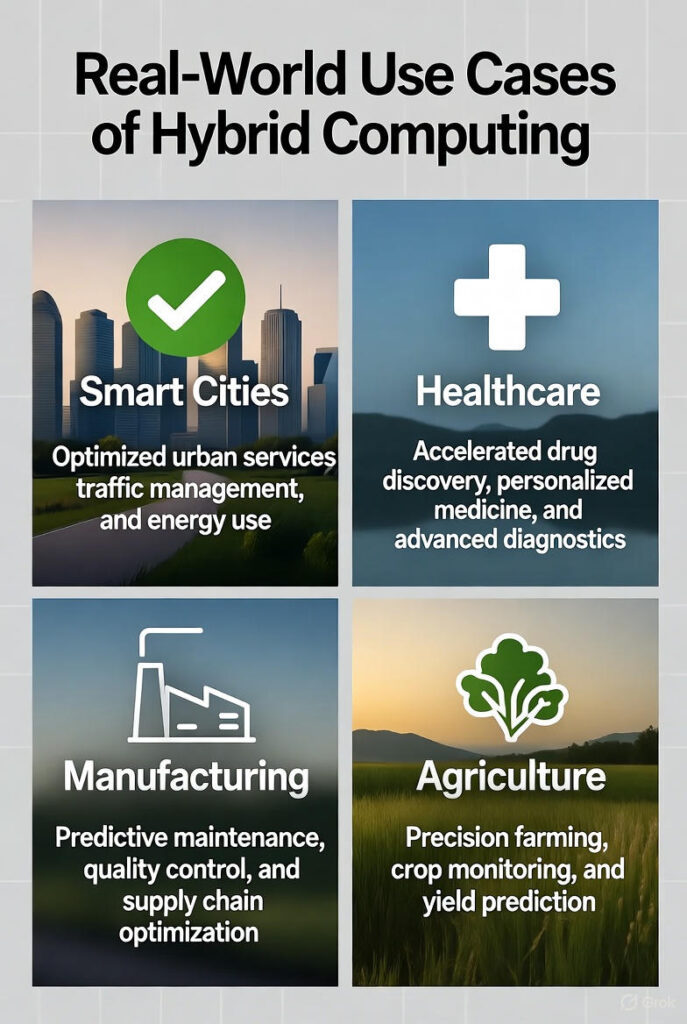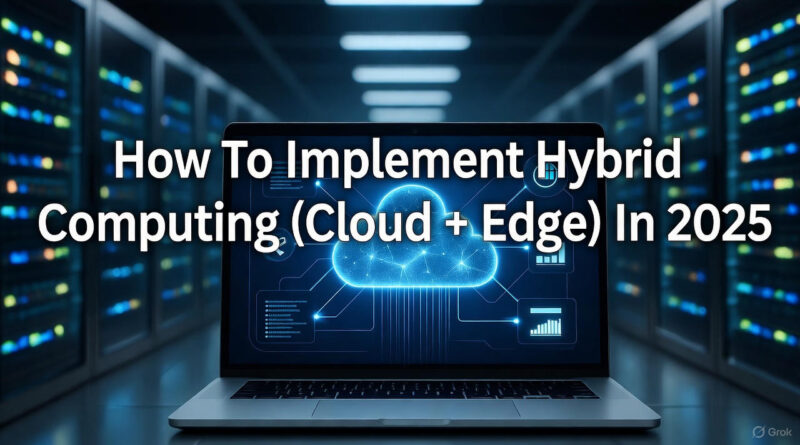How To Implement Hybrid Computing (Cloud + Edge) In 2025
How To Implement Hybrid Computing (Cloud + Edge) In 2025
In 2025, hybrid computing — a powerful blend of cloud and edge computing — has become a must-have architecture for modern businesses. From real-time analytics to IoT operations and AI-driven applications, companies are discovering that running workloads both in the cloud and at the edge delivers the best of both worlds: speed, scalability, and control.
But how do you actually implement hybrid computing effectively? This guide explains everything — from setup and integration to real-world use cases, tools, and best practices.
What Is Hybrid Computing?
Hybrid computing combines cloud computing (remote data centers offering storage and compute power) with edge computing (processing data closer to where it’s generated — like IoT devices or local servers).
Think of it like this:
-
Cloud = brain — where large-scale data processing and storage happen.
-
Edge = reflexes — where real-time decisions and local actions occur.
By connecting both, businesses gain speed, resilience, and efficiency while reducing latency and improving data privacy.
Why Hybrid Computing Matters in 2025

Here’s why hybrid cloud-edge setups are trending now:
-
Real-time data needs: Self-driving cars, drones, and manufacturing robots can’t wait for cloud responses.
-
Data privacy laws: Regulations like GDPR and Nigeria’s NDPR require local data handling.
-
Cost management: Companies can balance between cloud scalability and edge cost control.
-
AI & IoT explosion: Billions of devices need local inference with global synchronization.
-
Resilience: Hybrid architectures reduce downtime if the cloud connection fails.
According to Gartner (2024), over 70% of enterprises are expected to deploy hybrid architectures by 2026 — a 40% rise since 2022.
Step-by-Step Guide: How to Implement Hybrid Computing
Let’s dive into the practical steps for setting up a hybrid cloud + edge environment.
Step 1: Define Business and Technical Goals
Start by identifying why you need hybrid computing.
Ask:
-
Do you need faster response times for local devices?
-
Do regulations require local data processing?
-
Are cloud costs becoming unsustainable?
Once goals are clear, determine which workloads belong in the cloud and which should stay on the edge.
Example:
A hospital may store patient records in the cloud but process MRI images locally for speed and privacy.
Step 2: Choose the Right Hybrid Architecture
There are several hybrid models, depending on your business:
-
Cloud-first hybrid: Most processing in the cloud, critical tasks at the edge.
-
Edge-first hybrid: Most operations on-site, syncing only essential data to the cloud.
-
Distributed hybrid: Both cloud and edge share workloads dynamically.
Select based on latency tolerance, network strength, and data sensitivity.
Step 3: Pick Compatible Platforms and Tools
You need platforms that integrate cloud and edge seamlessly. Popular options include:
| Cloud Platform | Edge Companion | Description |
|---|---|---|
| Microsoft Azure | Azure Stack Edge | Unified management for AI + IoT |
| Amazon Web Services (AWS) | AWS IoT Greengrass | Extends AWS services to devices |
| Google Cloud | Anthos + Edge TPU | Containerized hybrid setup |
| IBM Cloud | IBM Edge Application Manager | Enterprise automation and AI support |
Choose tools that support:
-
APIs and microservices
-
Container orchestration (Kubernetes, Docker)
-
Secure communication protocols (HTTPS, MQTT)
Step 4: Integrate Data and Network Layers
Data must flow smoothly between cloud and edge. To achieve this:
-
Use APIs for real-time sync.
-
Set up data pipelines (Kafka, Apache NiFi, or AWS Kinesis).
-
Implement message queues for resilience during outages.
-
Ensure low-latency networks (5G, fiber, or SD-WAN).
Pro Tip: Always compress or filter data at the edge before sending it to the cloud. This reduces bandwidth use and cost.
Step 5: Strengthen Security and Compliance
Security is often the biggest challenge in hybrid computing.
Follow these best practices:
-
Use end-to-end encryption for data in transit and at rest.
-
Deploy identity and access management (IAM) for both environments.
-
Regularly audit edge devices for firmware updates.
-
Follow compliance laws (GDPR, NDPR, HIPAA, etc.).
-
Implement Zero Trust Architecture — never assume any node is safe.
Step 6: Deploy AI and Automation at the Edge
AI models trained in the cloud can be deployed at the edge for real-time inference.
Example:
A retail chain trains a demand forecasting model in the cloud but deploys it to local stores to instantly adjust inventory.
Use tools like:
-
TensorFlow Lite or ONNX Runtime for local inference
-
Azure ML Edge for hybrid model management
Step 7: Monitor, Optimize, and Scale
Once your system is live:
-
Use centralized monitoring dashboards (Prometheus, Grafana).
-
Track latency, resource usage, and security metrics.
-
Automate updates and backups through the cloud.
Over time, optimize by analyzing:
-
Cost vs. performance
-
Data transfer efficiency
-
Latency improvement
Real-World Use Cases of Hybrid Computing

1. Smart Cities
Edge sensors process traffic data locally while the cloud handles long-term analytics and optimization.
2. Healthcare
Hospitals process imaging data on-premise but store and analyze aggregated data in the cloud for AI insights.
3. Manufacturing
IoT machines use edge AI for real-time defect detection and upload summary data to the cloud ERP system.
4. Retail
Edge POS systems operate offline and sync to the cloud automatically when the network restores.
5. Agriculture
Smart farms use local weather sensors and drones for crop monitoring while global AI models optimize yield prediction.
Benefits of Hybrid Cloud + Edge Implementation
| Benefit | Description |
|---|---|
| Reduced Latency | Process data close to the source for instant responses. |
| Cost Efficiency | Send only necessary data to the cloud to save storage and bandwidth costs. |
| Scalability | Cloud handles spikes in workload without hardware upgrades. |
| Enhanced Security | Sensitive data stays local; encrypted communication ensures compliance. |
| Business Continuity | Edge nodes can continue operations even when offline. |
Common Challenges (and How to Solve Them)
| Challenge | Solution |
|---|---|
| Complex integration | Use managed hybrid platforms (Azure Arc, AWS Outposts). |
| Data synchronization issues | Implement event-driven architecture and message queues. |
| Security vulnerabilities | Apply Zero Trust, IAM, and frequent patching. |
| Lack of edge expertise | Train teams or partner with hybrid computing consultants. |
Tools and Frameworks to Explore in 2025
-
Kubernetes for container orchestration
-
Docker Swarm for lightweight edge deployments
-
Red Hat OpenShift for enterprise hybrid apps
-
VMware Edge Compute Stack
-
AWS Wavelength and Google Distributed Cloud Edge
These platforms make hybrid management easier and more automated.
Future of Hybrid Computing Beyond 2025

Hybrid computing is not a trend — it’s the foundation of next-gen distributed computing.
Expect to see:
-
AI-driven orchestration: Intelligent task routing between cloud and edge.
-
Sovereign clouds: Region-specific storage to comply with local data laws.
-
6G-powered edge: Ultra-low latency for AR/VR, drones, and remote surgery.
-
Quantum + edge convergence: Early quantum nodes supporting hybrid AI workloads.
In short, hybrid computing is shaping how the digital world operates — decentralized, faster, and smarter.
FAQs
1. What is hybrid cloud-edge computing?
It’s an architecture that merges cloud and edge computing to balance speed, scalability, and security.
2. Why is hybrid computing important in 2025?
Because industries now demand real-time processing and compliance with strict data laws while reducing cloud costs.
3. Is hybrid computing expensive to set up?
Initial setup can cost more, but long-term savings from reduced bandwidth and faster operations outweigh it.
4. What skills are needed for hybrid deployment?
Cloud engineering, networking, Kubernetes, data pipeline management, and cybersecurity knowledge.
5. How can small businesses use hybrid computing?
They can process daily operations locally while syncing backups and analytics to affordable cloud services like AWS or Azure.
Final Thoughts
Implementing hybrid computing (cloud + edge) is no longer optional — it’s essential for speed, resilience, and intelligent data handling in 2025. Whether you’re a startup optimizing IoT devices or an enterprise managing global workloads, hybrid setups unlock performance and scalability that traditional cloud-only systems can’t match.
Start small, plan smart, and evolve your infrastructure for the future of distributed intelligence.




